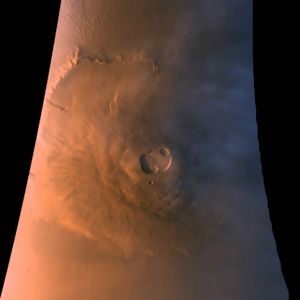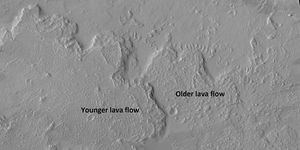Difference between revisions of "Olympus Mons"
(added info) |
m |
||
| Line 2: | Line 2: | ||
stands about two and a half times as tall as Mount Everest's height above sea level. It is the youngest of the large volcanoes on Mars. It is currently the largest volcano discovered in the Solar System and had been known to astronomers since the late 19th century as the albedo feature Nix Olympica (Latin for "Olympic Snow"). Its mountainous nature was suspected well before space probes confirmed its identity as a mountain.<ref>[[Patrick Moore]] 1977, ''Guide to Mars'', London (UK), Cutterworth Press, p. 96</ref> | stands about two and a half times as tall as Mount Everest's height above sea level. It is the youngest of the large volcanoes on Mars. It is currently the largest volcano discovered in the Solar System and had been known to astronomers since the late 19th century as the albedo feature Nix Olympica (Latin for "Olympic Snow"). Its mountainous nature was suspected well before space probes confirmed its identity as a mountain.<ref>[[Patrick Moore]] 1977, ''Guide to Mars'', London (UK), Cutterworth Press, p. 96</ref> | ||
| − | The volcano is located in Mars's western hemisphere at approximately | + | The volcano is located in Mars's western hemisphere at approximately 18.65 N and 226.2 E, just to the northwestern edge of the Tharsis bulge. The western portion of the volcano lies in the Amazonis quadrangle and the central and eastern portions in the Tharsis quadrangle. |
| − | |||
[[Image:Olympus_Mons.jpg|thumb|right|300px|Olympus Mons as seen by [[Mars Global Surveyor]]]] | [[Image:Olympus_Mons.jpg|thumb|right|300px|Olympus Mons as seen by [[Mars Global Surveyor]]]] | ||
Revision as of 08:50, 9 February 2018
Olympus Mons is a dormant shield volcano in the Tharsis region. It is the highest point on Mars. By one measure, it has a height of nearly 22 km (13.6 mi or 72,000 ft).[1] Olympus Mons stands about two and a half times as tall as Mount Everest's height above sea level. It is the youngest of the large volcanoes on Mars. It is currently the largest volcano discovered in the Solar System and had been known to astronomers since the late 19th century as the albedo feature Nix Olympica (Latin for "Olympic Snow"). Its mountainous nature was suspected well before space probes confirmed its identity as a mountain.[2]
The volcano is located in Mars's western hemisphere at approximately 18.65 N and 226.2 E, just to the northwestern edge of the Tharsis bulge. The western portion of the volcano lies in the Amazonis quadrangle and the central and eastern portions in the Tharsis quadrangle.

| This article is a stub. You can help Marspedia by expanding it. |
- ↑ "Morphometric Properties of Martian Volcanoes" (2004). J. Geophys. Res. 109. doi:. Bibcode: 2004JGRE..109.3003P.
- ↑ Patrick Moore 1977, Guide to Mars, London (UK), Cutterworth Press, p. 96







